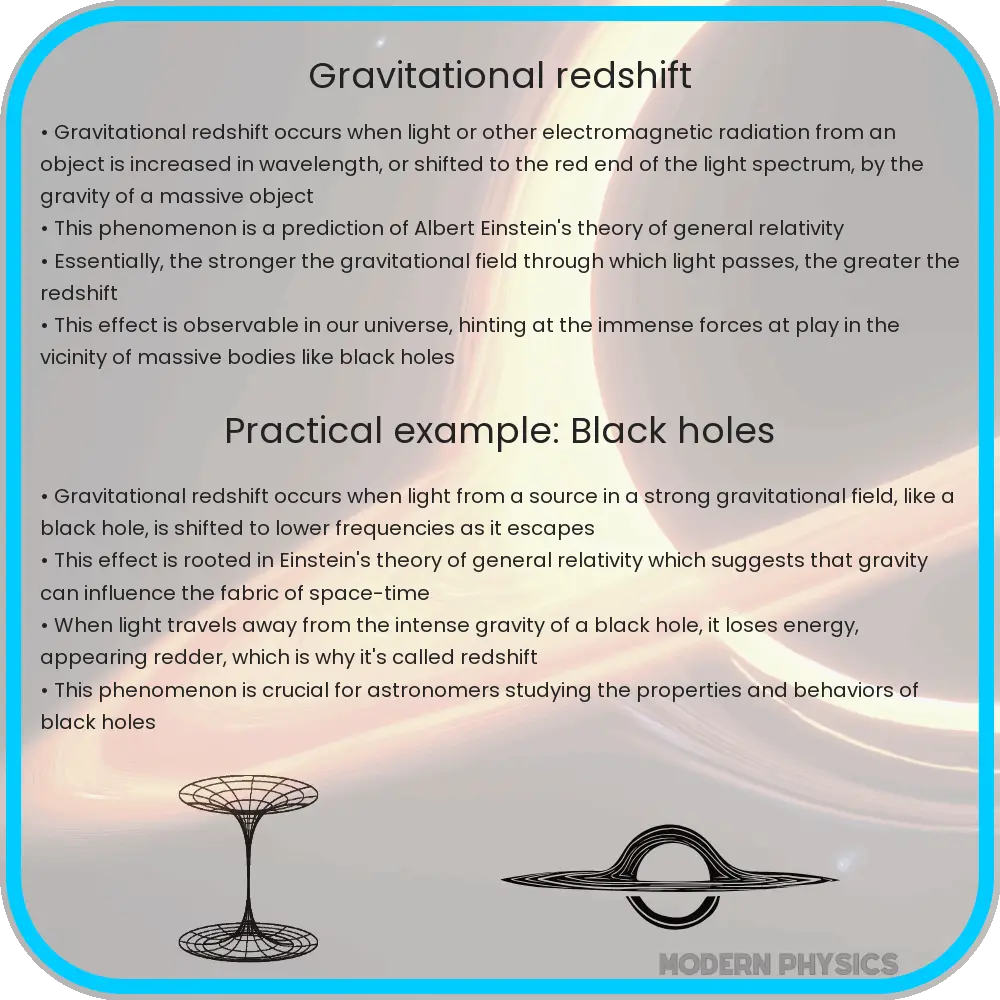Explore gravitational redshift’s impact in astrophysics and GPS technology, and its role in understanding the universe, black holes, and relativity.

Understanding Gravitational Redshift: A Fundamental Phenomenon
Gravitational redshift is a remarkable phenomenon predicted by Einstein’s theory of general relativity. It describes how light or other electromagnetic radiation originating from a source in a strong gravitational field gets shifted towards the red end of the spectrum as it moves away from the source. This effect occurs due to the influence of gravity on the wavelength of the light.
The Science Behind Gravitational Redshift
In the realm of physics, gravitational redshift emerges from the warping of spacetime caused by gravity. According to general relativity, a massive object like a star or planet distorts the spacetime around it. This distortion affects the path and properties of light traveling through that space. When light moves away from a massive object, its energy decreases, leading to an increase in its wavelength. This shift towards longer wavelengths is perceived as a shift towards the red part of the spectrum, hence the term ‘redshift’.
Mathematical Representation
The gravitational redshift can be quantified using the equation:
\[ z = \frac{\Delta \lambda}{\lambda} = \frac{G M}{R c^2} \]
Where:
- \( z \) is the redshift.
- \( \Delta \lambda \) is the change in wavelength.
- \( \lambda \) is the original wavelength.
- \( G \) is the gravitational constant.
- \( M \) is the mass of the celestial body.
- \( R \) is the radius from the center of the mass to the point of emission.
- \( c \) is the speed of light in a vacuum.
Impact on Astrophysics
Gravitational redshift has significant implications in astrophysics. It provides critical insights into the properties of massive celestial bodies. For instance, by measuring the redshift of light coming from the surface of a star, scientists can estimate the star’s mass and size. This measurement is pivotal in understanding the life cycle of stars and the dynamics of galaxies.
Applications in Modern Science
Beyond its theoretical importance, gravitational redshift has practical applications. One of the most notable is in the field of satellite communication and GPS technology. The accurate functioning of GPS satellites relies on accounting for the effects of gravitational redshift on their onboard atomic clocks. Without corrections for this redshift, GPS systems would quickly become inaccurate, leading to errors in navigation and timing.
Another application is in the testing and validation of theories of gravity. Observations of gravitational redshift help in verifying the predictions of general relativity and in exploring potential new theories of gravity.
Exploring the Universe Through Gravitational Redshift
Gravitational redshift not only aids in understanding the fundamental properties of celestial objects but also serves as a crucial tool in exploring the universe. By analyzing the redshift of light from distant galaxies, astronomers can delve into the history and expansion of the universe. This exploration is vital for cosmology, providing evidence for theories like the Big Bang and aiding in the study of dark matter and dark energy.
Gravitational Redshift and Black Holes
One of the most intriguing applications of gravitational redshift is in the study of black holes. The intense gravitational fields of black holes cause extreme redshifts, offering a unique opportunity to study these enigmatic objects. Observations of light near black holes can reveal information about their mass, spin, and the nature of spacetime in these extreme environments.
Challenges and Future Prospects
Despite its wide range of applications, observing gravitational redshift is not without challenges. The precision required to detect redshifts caused by less massive objects, like planets, is extremely high. Future advancements in technology and observational methods are expected to overcome these challenges, allowing for more detailed studies and potentially revealing new aspects of gravitational physics.
Advancements in quantum mechanics and the pursuit of a unified theory of physics also see gravitational redshift as a key component. Understanding how gravity works at quantum scales, possibly through phenomena like gravitational redshift, might pave the way for new discoveries in physics.
Conclusion
Gravitational redshift is a profound and versatile phenomenon that transcends its role as a mere prediction of general relativity. It has become an indispensable tool in astrophysics, cosmology, and the study of black holes. Its influence extends to practical applications like GPS technology, highlighting the interconnectedness of theoretical physics and everyday technology. As we continue to explore the universe and unravel its mysteries, gravitational redshift remains a beacon, guiding our understanding of the cosmos and the fundamental laws that govern it. The future of gravitational redshift research promises not only deeper insights into known cosmic phenomena but also the potential to uncover new realms of physics, challenging and expanding our understanding of the universe.
Is this conversation helpful so far?
